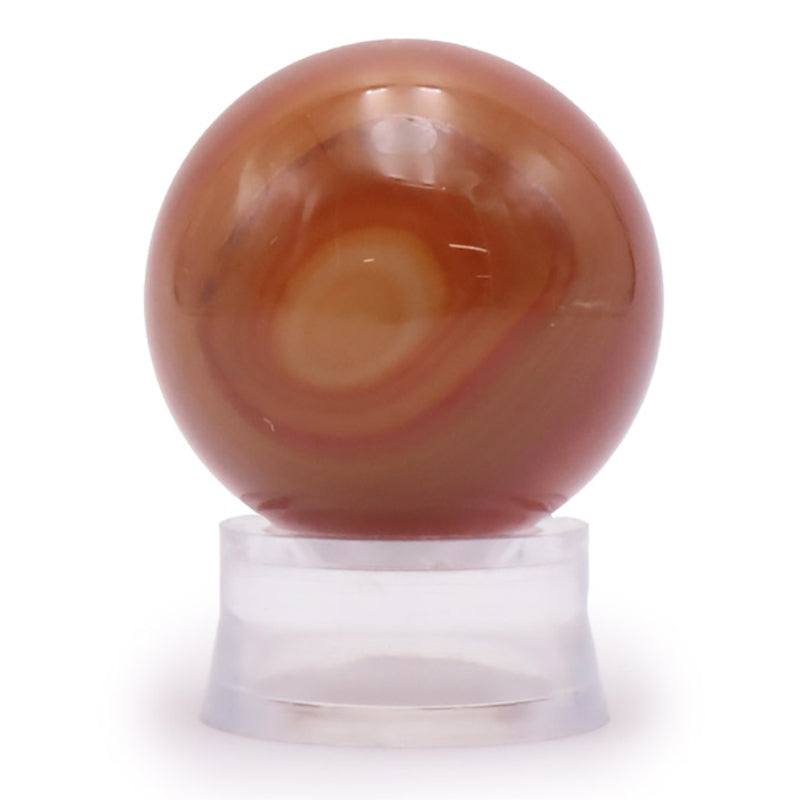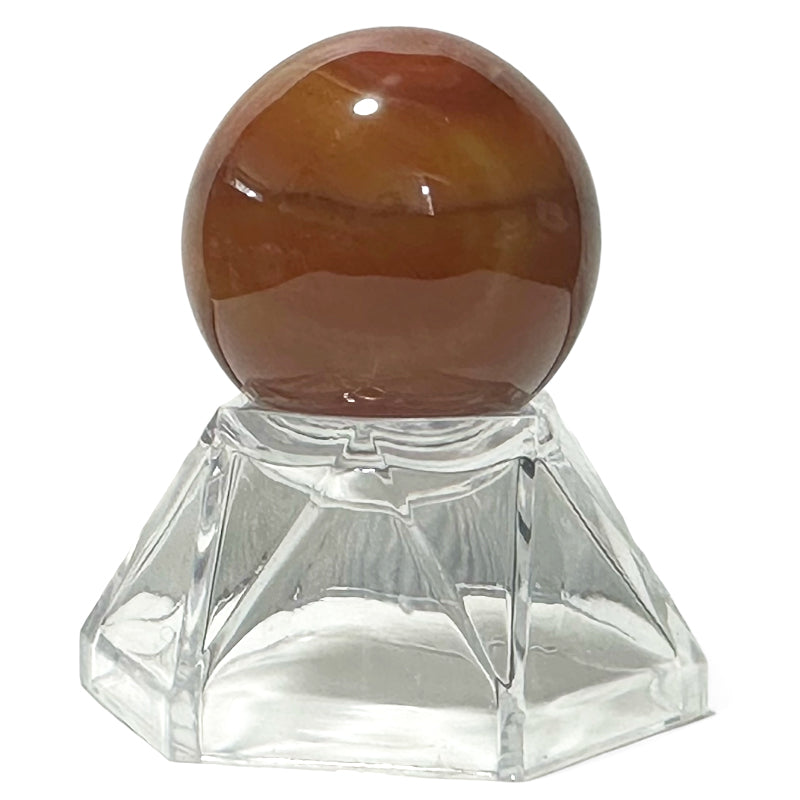1
/
of
3
Carnelian sphere Brazil A - 30mm
BOU-COR-02
8c984efa-30a8-5524-41cc-ae7b332135e6
028d80eb-2b30-41d4-b221-bda49eca04cf
- Regular price
-
12,90 € - Regular price
-
12,90 € - Sale price
-
12,90 €
Tax included.
Shipping calculated at checkout.
Couldn't load pickup availability
Learn more
BOU-COR-02
Origin: Brazil
Grade: A
Dimensions:
30mm
Weight:
About 40g
Very beautiful 30mm carnelian sphere from Brazil
Colors and patterns vary from stone to stone.
Support sold separately in the accessories section
Carnelian belongs to the microcrystalline quartz family. It is a red variety of chalcedony. It owes its beautiful color to inclusions of hematite, a natural iron oxide. The intensity of its color, red to orange, is linked to its iron concentration.
It is also composed of aluminum oxide and silica. This red quartz comes from volcanic rocks at low temperatures. The vermilion red color is the most appreciated, so it is often obtained by heating the stone or exposing it to the sun for a long time.
Carnelian is very slightly translucent, even opaque and its pleochroism is weak (the ability to see light pass through the stone and show various colors). It has a hardness between 6 and 7 on the Mohs scale.
There are several hypotheses regarding the etymology of cornelian. Some assume that the name comes from the dogwood tree, a shrub that grows in eastern Mediterranean countries. It produces a fruit with a beautiful red color that is relatively identical to that of cornelian. The origin of the name cornelian comes from the Latin "corneolus".
Others claim that this name comes from the Latin "carne” meaning meat. But in both cases, carnelian owes its name to its beautiful orange-red color. As early as the 16th century, the stone was definitively named "carnelian".
Carnelian has been used for thousands of years. In the early 20th century, British archaeologist Leonard Woolley discovered the tomb of Puabi during his excavations. She was a very important figure in the Sumerian city of Ur during the First Dynasty of Uruk between 2750 and 2550 BC. She was covered in magnificent necklaces and a headdress of gold, including carnelians and lapis lazuli. The latter is on display in Pennsylvania at the Museum of Archaeology. In the neighboring tomb, the standard of Ur was discovered in the form of a small ivory chest decorated with red Indian carnelian. This small chest reveals the history of this civilization. It is, for its part, on display at the British Museum in London.
Still around 2,700 BC, this orange stone appeared in ancient Egypt. It was given as an offering to Isis, mythical queen and funerary goddess, in order to accompany the dead on their journey to the afterlife. Carnelian was also used as a stone of magnificence and ornament, with a protective vocation. It is identified on the headdresses of pharaohs and on many talismans. In addition, this stone with orange-red colors, associated with the colors of the sun, spiritually represents the Sun god. It was also found on paintings or used as a natural medicine.
Unlike the Egyptians, the Greeks and Romans used this stone only for making jewelry and seals and did not attribute any healing powers to it. Gods and symbols of luck were engraved in the red stone. Pliny the Elder, a Roman naturalist of the 1st century AD, describes it in his encyclopedia Natural History. He even distinguishes between male stones, which are very red, and female stones, which are more orange-yellow.
In the Middle Ages, carnelian was believed to have healing powers. At that time, when battles were raging, carnelian was believed to give courage to warriors and protect them from bleeding.
In China, the Chinese accentuated the red color of carnelian by including copper oxide, then used it to glaze their fine porcelain. Carnelian was crushed and made into a pigment for decorating art objects.
In France, during the Renaissance, carnelian was a stone that attracted many artists. Then, from the 17th century, Dutch maritime trade brought back a large number of carnelians straight from the Orient. Little by little, they spread to the manufacture of jewelry, ornamental objects and goldsmithing. This trade made them lose their rarity and led to a drop in prices.
The main deposits are located in Brazil, Madagascar, Botswana, etc.
In lithotherapy, Carnelian is a stone of serenity and appeasement. It has the ability to strengthen self-confidence and promotes spontaneity. It develops the joy of living and encourages one to enjoy every moment.
Associated with boldness since Antiquity, this stone restores energy, vitality, courage and regulates excessive egos. It facilitates public speaking and provides beautiful eloquence. It engenders confidence, but not arrogance.
Carnelian encourages the fight against states of intense sadness. In addition, it calms anger, jealousy, and resentment. It helps to overcome certain traumas related to the past and becomes a stone of resilience.
In overly sensitive people, this stone can make them stronger, give them more confidence and help them assert themselves. It provides creativity and promotes concentration by channeling overly agitated thoughts.
It is a stone known to bring joy of life, good humor, happiness and enthusiasm. Its vitamin color diffuses a well-being that allows you to manage complicated situations gently. Unlike most red stones, carnelian regulates excess energy instead of increasing it.
A true lucky charm, carnelian spreads its protection throughout the home and promotes relationships by maintaining a soft and serene atmosphere. It encourages understanding between people.
Origin:
Brazil
Grade:
A = good
Very beautiful 30mm carnelian sphere from Brazil
Colors and patterns vary from stone to stone.
Support sold separately in the accessories section
Carnelian belongs to the microcrystalline quartz family. It is a red variety of chalcedony. It owes its beautiful color to inclusions of hematite, a natural iron oxide. The intensity of its color, red to orange, is linked to its iron concentration.
It is also composed of aluminum oxide and silica. This red quartz comes from volcanic rocks at low temperatures. The vermilion red color is the most appreciated, so it is often obtained by heating the stone or exposing it to the sun for a long time.
Carnelian is very slightly translucent, even opaque and its pleochroism is weak (the ability to see light pass through the stone and show various colors). It has a hardness between 6 and 7 on the Mohs scale.
There are several hypotheses regarding the etymology of cornelian. Some assume that the name comes from the dogwood tree, a shrub that grows in eastern Mediterranean countries. It produces a fruit with a beautiful red color that is relatively identical to that of cornelian. The origin of the name cornelian comes from the Latin "corneolus".
Others claim that this name comes from the Latin "carne” meaning meat. But in both cases, carnelian owes its name to its beautiful orange-red color. As early as the 16th century, the stone was definitively named "carnelian".
Carnelian has been used for thousands of years. In the early 20th century, British archaeologist Leonard Woolley discovered the tomb of Puabi during his excavations. She was a very important figure in the Sumerian city of Ur during the First Dynasty of Uruk between 2750 and 2550 BC. She was covered in magnificent necklaces and a headdress of gold, including carnelians and lapis lazuli. The latter is on display in Pennsylvania at the Museum of Archaeology. In the neighboring tomb, the standard of Ur was discovered in the form of a small ivory chest decorated with red Indian carnelian. This small chest reveals the history of this civilization. It is, for its part, on display at the British Museum in London.
Still around 2,700 BC, this orange stone appeared in ancient Egypt. It was given as an offering to Isis, mythical queen and funerary goddess, in order to accompany the dead on their journey to the afterlife. Carnelian was also used as a stone of magnificence and ornament, with a protective vocation. It is identified on the headdresses of pharaohs and on many talismans. In addition, this stone with orange-red colors, associated with the colors of the sun, spiritually represents the Sun god. It was also found on paintings or used as a natural medicine.
Unlike the Egyptians, the Greeks and Romans used this stone only for making jewelry and seals and did not attribute any healing powers to it. Gods and symbols of luck were engraved in the red stone. Pliny the Elder, a Roman naturalist of the 1st century AD, describes it in his encyclopedia Natural History. He even distinguishes between male stones, which are very red, and female stones, which are more orange-yellow.
In the Middle Ages, carnelian was believed to have healing powers. At that time, when battles were raging, carnelian was believed to give courage to warriors and protect them from bleeding.
In China, the Chinese accentuated the red color of carnelian by including copper oxide, then used it to glaze their fine porcelain. Carnelian was crushed and made into a pigment for decorating art objects.
In France, during the Renaissance, carnelian was a stone that attracted many artists. Then, from the 17th century, Dutch maritime trade brought back a large number of carnelians straight from the Orient. Little by little, they spread to the manufacture of jewelry, ornamental objects and goldsmithing. This trade made them lose their rarity and led to a drop in prices.
The main deposits are located in Brazil, Madagascar, Botswana, etc.
In lithotherapy, Carnelian is a stone of serenity and appeasement. It has the ability to strengthen self-confidence and promotes spontaneity. It develops the joy of living and encourages one to enjoy every moment.
Associated with boldness since Antiquity, this stone restores energy, vitality, courage and regulates excessive egos. It facilitates public speaking and provides beautiful eloquence. It engenders confidence, but not arrogance.
Carnelian encourages the fight against states of intense sadness. In addition, it calms anger, jealousy, and resentment. It helps to overcome certain traumas related to the past and becomes a stone of resilience.
In overly sensitive people, this stone can make them stronger, give them more confidence and help them assert themselves. It provides creativity and promotes concentration by channeling overly agitated thoughts.
It is a stone known to bring joy of life, good humor, happiness and enthusiasm. Its vitamin color diffuses a well-being that allows you to manage complicated situations gently. Unlike most red stones, carnelian regulates excess energy instead of increasing it.
A true lucky charm, carnelian spreads its protection throughout the home and promotes relationships by maintaining a soft and serene atmosphere. It encourages understanding between people.



Carnelian sphere Brazil A - 30mm
- Regular price
-
12,90 € - Regular price
-
12,90 € - Sale price
-
12,90 €
8c984efa-30a8-5524-41cc-ae7b332135e6
028d80eb-2b30-41d4-b221-bda49eca04cf
-
100% SECURE PAYMENT
Paypal, credit card, check, transfer
-
FREE DELIVERY
from 40€ purchase
-
SATISFIED OR REFUNDED
14 days to change your mind
-
CUSTOMER SERVICE AVAILABLE
contact@laboiteacailloux.com
Subscribe to our newsletter
to receive all our offers, good deals and new products from La Boite à Cailloux



